 |
Казыгурт - В поисках священного ковчега
In searches of a sacred ark (В поисках священного ковчега)
Holy scripts (Zabur, Taurat, Inzhil, and the Koran)
contain a myth about a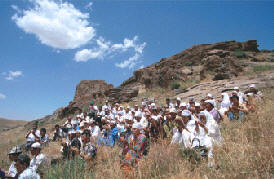 righteous person named Nukhe-paigambar (Noah in Christianity). In an
epochal act he saved himself, his whole family and fauna specimens from
the Flood. Warned by the Lord, he constructed an enormous ark (keme)
where he placed "a pair of each animal". According to ancient legends, at
the time of the Flood, Noah's Ark (Nukh-paigambar) stopped at the Al-Zhudi
Mount in Arabia, the Ararat Mount in the Caucasus, Sinai in Palestine, and
the Kazygurt Mount in Kazakhstan.
righteous person named Nukhe-paigambar (Noah in Christianity). In an
epochal act he saved himself, his whole family and fauna specimens from
the Flood. Warned by the Lord, he constructed an enormous ark (keme)
where he placed "a pair of each animal". According to ancient legends, at
the time of the Flood, Noah's Ark (Nukh-paigambar) stopped at the Al-Zhudi
Mount in Arabia, the Ararat Mount in the Caucasus, Sinai in Palestine, and
the Kazygurt Mount in Kazakhstan.
The legendary place is (40 km from Shymkent) in the
spurs of the Talass Alatau (western ridge of the Tien-Shan mountains).
People have preserved about 50 legends about the mountain's holiness. People
believe the place where the Ark stopped is still visible on the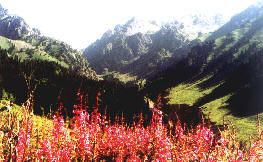 mountain.
Locals call it "Keme Kalgan" (Place of Noah's Ark). Amazingly, the size of
"the local ark" is the same as in the description in one of the holy
scripts, "The length of the ark three hundred cubits (150 m.), its width
fifty cubits (25 m.), and its height thirty cubits (15 m.)". mountain.
Locals call it "Keme Kalgan" (Place of Noah's Ark). Amazingly, the size of
"the local ark" is the same as in the description in one of the holy
scripts, "The length of the ark three hundred cubits (150 m.), its width
fifty cubits (25 m.), and its height thirty cubits (15 m.)".
The mountain has the second summit where another
mystical thing was found: an equilateral cross made of stones. Its
diameter is 100 meters; the length of crossbars is 38 meters. There are
several versions of the origin of that unusual "sign". Some researchers
relate it to prophet Zarathustra. The huge cross made of stones may have
been made with a ritual purpose by Zoroastrians, followers of the teaching
of Zarathustra. According to other versions, similar crosses - signs of
Tengri, god of the sky - were made several centuries before Christ in the
Altai, which was an ancient homeland of the Turki.
There are a lot of other tales about unusual properties
of this place. Saint Akbura-Ata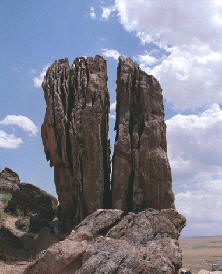 lived at the foot of the Kazygurt Mount. He called people to believe in
one God. He treated them with herbs, prophesied, and had other
supernatural abilities.
lived at the foot of the Kazygurt Mount. He called people to believe in
one God. He treated them with herbs, prophesied, and had other
supernatural abilities.
The Shilter-Ata nature complex is also cited among holy
places. Ata-Ana rock symbolizes the forbearers of the human race - Adam
and Eve. Two 33 meter high rocks have a passage between them through which
only a godly person may go. In Shilter-Ata there are stone statues of
animals described in holy books. The area of the Kazygurt national park
seems to have a supernatural aura.
33 archeological monuments have been found in the
Kazygurt mountains and in its proximity. The bulk is located in upper
reaches of the Keles river and its inflows. The Great Silk Road went
through Kazygurt. From here the shortest routes to Uzbekistan, ancient
Tashkent, Bukhara, Khiva, and Samarkand, start. 3,000 year old Sairam (Ispidjab)
is located in 20-30 kilometers from the Kazygurt Mount. In Sairam, an
unusual underground construction was discovered (VI-VIII cc.). Scientists
think it is a Buddha temple. According to some written sources, Turbat
settlement (XII-XVII cc.) and Sharapkhana (VI-XVI cc.) are nothing but the
ancient city of Gazgird. Legends (ordabasy) mention this place in
connection with the Jungar invasion.
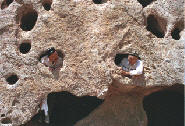 The
nature in this region is rich and splendid. Close by, Aksu-Dzhabagly, one
of the first nature preserves in Kazakhstan (1926), is situated. In 1934,
it was awarded status of a UNESCO biosphere preserve. All splendor of the
nature can be found here: deep rocky gorges, scenic meadows, and the
steppe. Rich fauna and flora have been preserved here in their virginity:
238 species of birds, 42 species of animals, 9 species of reptiles, and
1,300 different kinds of plants. Another creation of Mother Nature, the
strikingly beautiful Aksu canyon at 3,000 meters above the sea level, is a
paleontology preserve featuring rock drawings. The
nature in this region is rich and splendid. Close by, Aksu-Dzhabagly, one
of the first nature preserves in Kazakhstan (1926), is situated. In 1934,
it was awarded status of a UNESCO biosphere preserve. All splendor of the
nature can be found here: deep rocky gorges, scenic meadows, and the
steppe. Rich fauna and flora have been preserved here in their virginity:
238 species of birds, 42 species of animals, 9 species of reptiles, and
1,300 different kinds of plants. Another creation of Mother Nature, the
strikingly beautiful Aksu canyon at 3,000 meters above the sea level, is a
paleontology preserve featuring rock drawings.
The
Kazygurt mountain range is of utmost natural, historical, esthetic and
scientific value. This place is a symbol of unity and spiritual revival of
nations.
In the near future, the summit will be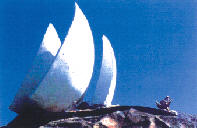 decorated with a
monument. Kazakhstan's architects are currently considering a two-part
monument, the light part will be above the ground while the dark one will
be underground. The over ground part will look like three huge sails set
under different angles. A wide staircase will lead to the underground
part, which will look like an archeological excavation with the Ark's bow
and the left board with oars emerging from the soil. decorated with a
monument. Kazakhstan's architects are currently considering a two-part
monument, the light part will be above the ground while the dark one will
be underground. The over ground part will look like three huge sails set
under different angles. A wide staircase will lead to the underground
part, which will look like an archeological excavation with the Ark's bow
and the left board with oars emerging from the soil.
Visiting season: May- October
|